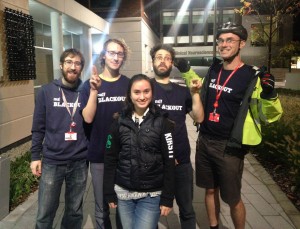First things first: A huge thank you to all of the student and staff volunteers that joined us for some serious energy-saving escapades (and a shout-out to those who helped by powering down their rooms as they left for the weekend). Fifteen teams of committed carbon-cutters helped cover fourteen buildings on three King’s campuses Friday evening. It couldn’t have been done without so much help, so thanks very much indeed.
So, how much energy did we manage to save?
Quite a lot! We switched off 508 computers, 559 monitors, 522 lights and 131 printers, among other things. Overall, Blackout made for a 12% reduction in energy use compared to an average November weekend, amounting to roughly 8 tonnes of carbon saved (and nearly £2000, if anyone is counting). As such, each participant managed to save about 130 kilos of carbon. In one evening! If we did this every weekend, King’s would save 432 tonnes of carbon (and almost £100,000!) in a year. Of course, these numbers could be significantly higher with wider participation across the university. Among buildings we covered, the Henry Wellcome building at Denmark Hill saw the greatest reduction at a massive 46%. The Strand building fared pretty well, too, with a reduction of 21%, while the Macadam saw a 20% reduction.

One of two Waterloo teams, rightly impressed with themselves after helping to switch off every classroom at FWB.
These are some pretty big numbers. But what do they mean, in everyday terms? Let’s just look at computers. If the 500 computers we switched off were left on over the weekend, they would have produced enough carbon to fill more than four London buses. That would be one stuffy commute! The 550 monitors, meanwhile, use enough energy over a weekend to microwave a little over 10,000 dinners (figures from the Carbon Trust). Of course, these are just a portion of the computers even in the limited spaces we covered. Across the five campuses, there are nearly 1300 student computing stations. That’s a lot of potential energy savings. Indeed, this weekend has clearly demonstrated what a major impact the simple actions of staff and students can have in reducing the College’s energy use. Combining those actions with the College’s own plans for increasing efficiency and reducing emissions can make a huge difference going forward.
Blackout has been a major focus of ours for some time, but it’s not the only thing that Sustainability has been up to. The NUS caught up with our Sustainable Labs Project Coordinator, Martin Farley, to ask him some questions about the importance of laboratories in sustainability, and he offered some insight into what his work entails (labs, by the way, were not included in Blackout). We are all getting ready for the launch of Green Impact next month, which you will read a lot about in this space as things develop. Beginning next week we’ll be offering glimpses into some of the most sustainable minds on campus through profiles of our team members. If you’re interested in what we’re up to, be sure to stay tuned.
Until then, keep it sustainable. And thank you once more to those who helped with Blackout last week!
Upcoming events
- Wednesday, 19 November, 11.00-14.30: Cycling event at Guy’s quad
- Tuesday, 25 November, 18.00: Second EcoSoc panel of the year
- Tuesday, 2 December, 18.00: Second Sustainability Forum
Some news and stories
- US and China, world’s biggest polluters, agree to substantial emission cuts
- Oxford diocese divests from fossil fuels, calls on Church of England to follow suit
- Netherlands installs world’s first solar bicycle path (Bonus: they can be pretty, too)
- BMW develops street-light electric car chargers





Great job!! Hope that a better understanding of how a little goes a long way will inspire greater participation. You guys are setting a great example:)